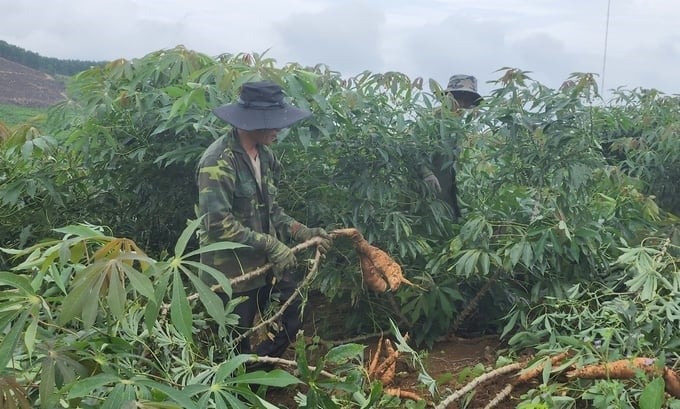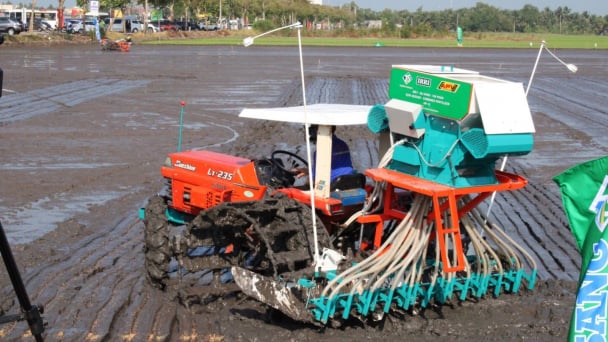May 21, 2025 | 08:19 GMT +7
May 21, 2025 | 08:19 GMT +7
Hotline: 0913.378.918
May 21, 2025 | 08:19 GMT +7
Hotline: 0913.378.918

Phu Yen farmers harvest cassava. Photo: KS.
However, in recent years, this crop has been experiencing degeneration, low productivity, and diseases due to continuous cultivation for many years.
Cassava is one of the crops that is easy to grow, has good drought resistance, requires little investment, and is suitable for terrains and soil types that other crops cannot grow. Under normal conditions, each hectare of cassava can bring an income of tens of millions of dong per crop. The above-mentioned factors have helped cassava be chosen by many farmers, especially households without much investment capital and in areas with difficulty in terms of irrigation water.
In Phu Yen province, in recent years, the cassava growing area has grown to over 26,000 hectares/year. Most of the cassava area is grown in the form of extensive farming on mountainous areas in Song Hinh, Son Hoa, and Dong Xuan districts, so they lack or have no irrigation water.
According to the Phu Yen Sub-Department of Crop Production and Plant Protection, the irrigated cassava growing area in the province currently only reaches 5–7%. Crop rotation and intercropping measures for cassava are also only applied on a small scale. People in Phu Yen now grow the main cassava varieties, including KM419, KM94, KM140, and additional varieties such as KM414-2, KM98-5, KM440, KM444, KM397, etc. The average productivity only reaches 20–22 tons/ha.
According to records in the mountainous district of Song Hinh, cassava, rice, and sugarcane are the main crops of this district. Mr. Dinh Ngoc Dan, Chairman of Song Hinh District People's Committee, said that in recent times, cassava has made an important contribution to creating jobs and income for farmers, especially ethnic minorities. Every year, the cassava growing area in the district is about 10,000–12,000 hectares (second only to rice), reaching a productivity of over 17 tons/ha and an output of about 200,000 tons.
With the current average raw cassava purchasing price of about VND 3,350/kg (flour level 30), farmers have an income of about VND 60 million/ha. However, in recent years, climate change has created extreme weather, leading to land degradation. Along with that, cassava varieties in the district have degenerated, have low productivity, and are infected with diseases due to continuous cultivation for many years. Especially since 2020, the appearance of cassava mosaic disease and Tetranychus urticae has caused serious damage to most cassava-growing areas of the district.

Farmers have headaches with mosaic disease, causing cassava productivity to decrease significantly, thereby affecting income. Photo: KS.
Mr. Nguyen Van Quoc, a cassava grower in Son Giang commune (Song Hinh district), said that in recent years, mosaic disease has continuously appeared, so many people's cassava fields have failed and lost income. For example, his family has 6 acres of cassava-growing land. Even though they have taken care of it and applied many technical measures for prevention, the disease situation has not improved.
Viral mosaic disease began to arise and cause damage to cassava in the province in 2018, with an area of 11.5 hectares in EaLy commune (Song Hinh district). Currently, each year, this disease damages about 16,000 hectares of cassava varieties, including KM419, KM140, KM94, KM98-5, etc.
"Previously, from 3 acres of cassava-growing land, I harvested more than 6 tons of fresh tubers. However, since 2021, cassava plants have been infected with mosaic disease, so the tuber productivity has decreased by more than 3 tons," Mr. Quoc lamented.
Meanwhile, there is currently no specific pesticide to prevent the virus that causes cassava mosaic disease, so farmers mainly prevent the disease. When cassava plants are infected with disease, they must be destroyed. Therefore, the most difficult problem for farmers today is the lack of disease-free cassava varieties to deploy new plantings.
According to Mr. Nguyen Van Minh, Director of the Phu Yen Sub-Department of Crop Production and Plant Protection, in recent years, cassava plants in the area have faced a number of harmful organisms, especially viral mosaic disease.
Specifically, in 2021 and 2022, the prolonged hot sun caused Tetranychus urticae to appear, seriously damaging an area of about 1,430 hectares of cassava in Dong Xuan, Son Hoa, Song Hinh, and Phu Hoa districts. In 2023 and early 2024, the cassava area damaged by Tetranychus urticae was about 500 hectares and 990 hectares in Dong Xuan, Song Hinh, and Son Hoa districts, respectively.
In addition to the above limitations and difficulties, the leader of the Phu Yen Sub-Department of Crop Production and Plant Protection also said that the level of mechanization in cassava production in the province is not synchronous, mainly only reaching a high rate in the tillage stage (about 98.5%) and transportation stage (about 95%). As for stages such as planting, tending, and harvesting, the level of mechanization is still very low (about 10%).

Currently, Phu Yen province produces about 26,000 hectares/year. Photo: KS.
In Phu Yen province, there are currently two cassava starch processing businesses, including Phu Yen Tapioca Starch Joint Stock Company and Dong Xuan Tapioca Starch Production Factory, that purchase cassava in the province.
However, businesses paying attention to investing in raw material areas are still limited; support for seed and material investment only stops at small-scale models; there is no close connection and replication throughout the business's raw material areas; and the chain linkage model according to Decree No. 98/2018 dated July 5, 2018 of the Government has not been implemented.
According to the Song Hinh Department of Agriculture and Rural Development, Phu Yen Tapioca Starch Joint Stock Company, located in the district, has a capacity of 1,500 tons of tubers/day and an annual output of raw materials of about 300,000 tons. However, in recent years, the company has only purchased about 120,000–150,000 tons/year. Due to a shortage of on-site raw materials, the company has to purchase them from neighboring provinces.
The Song Hinh Department of Agriculture and Rural Development said that there are three main reasons for the lack of on-site raw materials for the company. First, the linkage between cassava farmers and the company has not been close. The company has not really paid attention to investing in disease-free seed sources, has not built irrigated cassava growing models to improve productivity, and has not had constraint contracts for linking production and product consumption between parties, allowing farmers to sell cassava to weighing stations rather than to factories.
Second, pests such as Tetranychus urticae, pink mealybugs, and mosaic disease causing damage to cassava plants are becoming more and more serious, leading to a significant decrease in cassava productivity and output in the area. Accordingly, in the 2018–2019 crop year, Song Hinh district's cassava productivity reached an average of 23 tons/ha, but by the 2022–2023 crop year, it decreased to only 17–18 tons/ha. Some cassava fields even reached a productivity of 13–15 tons/ha. Currently, all super tuber cassava varieties in the district, such as KM140 and KM419, are seriously infected with mosaic disease.
Third, the current weather situation is complicated, with hot sun and drought continuously occurring. If farmers continue to get used to traditional production using "sky water," fertilizing only when it rains, cassava plants will have serious shortages of nutrition and water, and productivity will be very low.
According to the Song Hinh Department of Agriculture and Rural Development, in the 2023–2024 crop year, the entire district grew 9,550 hectares of cassava, reaching a productivity of 18 tons/ha and an output of about 172,000 tons. With an average raw cassava purchasing price of VND 3,350/kg (flour level 30), farmers earn about VND 50 million/ha. After deducting costs, the profit is quite low, about VND 15–20 million/ha. In cassava fields with low productivity of only 12–13 tons/ha, farmers have almost no profit or loss.
Translated by Thu Huyen

(VAN) In 2024, over 295 million people across 53 countries and territories faced acute hunger—an increase of almost 14 million people compared to 2023, while the number of people facing catastrophic levels of hunger reached a record high.

(VAN) World Environment Day 2025 (June 5) carries the theme 'Beat Plastic Pollution' continuing to emphasize the global urgency of addressing the plastic waste crisis.

(VAN) This was the assessment shared by experts at the workshop titled 'Assessing the Role and Potential of Low-Emission Rice Production Systems in Vietnam,' held on the morning of May 19.

(VAN) Cai Rong Port is the fisheries control center of Quang Ninh, helping to monitor fishing vessels, combat IUU fishing, and remove the EC's 'yellow card'.

(VAN) The German Agricultural Society (DLG) explores the possibility of establishing a mechanization service center in Vietnam’s Mekong Delta to support farmers in accessing and utilizing advanced machinery.

(VAN) On May 16, the Department of Water Resources Management, in collaboration with the Food and Agriculture Organization of the United Nations (FAO), held a signing ceremony for the GEF-8 project document.

(VAN) Food safety, mechanization, vocational training, and market opening are key areas of cooperation expected between the Vietnamese Government and the Federal Republic of Germany.